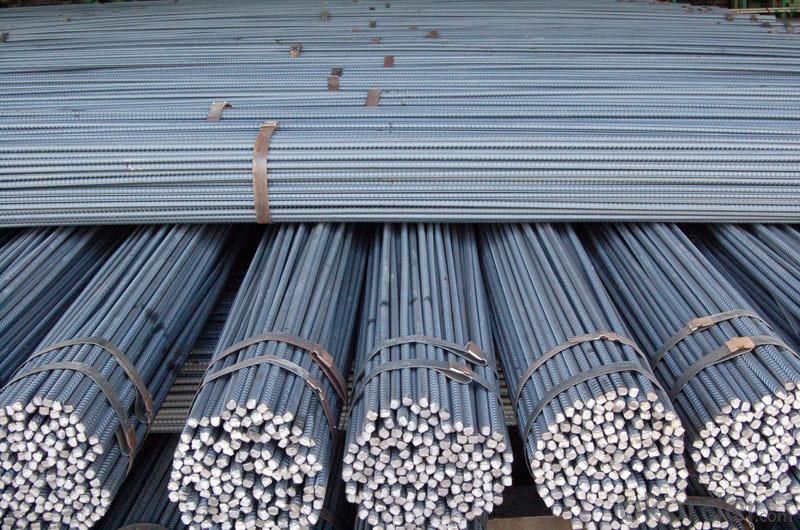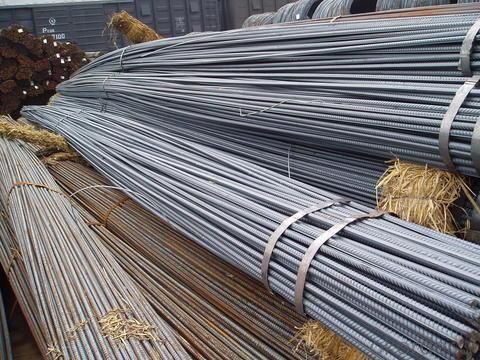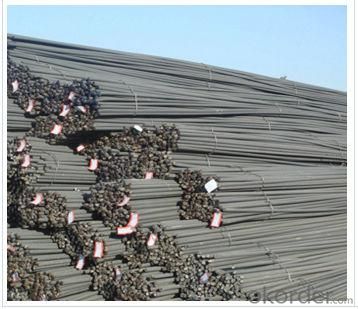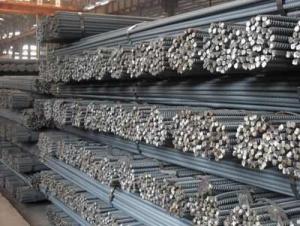0.222kg/m BST500S deformed steel bar for construction
- Loading Port:
- Tianjin
- Payment Terms:
- TT OR LC
- Min Order Qty:
- 25 m.t.
- Supply Capability:
- 100000 m.t./month
OKorder Service Pledge
OKorder Financial Service
You Might Also Like
Product Applications:
Steel Rebar Deformed Bar High Quality Hot Rolled Steel are ideal for structural applications and are widely used in the construction of buildings and bridges, and the manufacturing, petrochemical, and transportation industries.
Product Advantages:
OKorder's Steel Rebar Deformed Bar High Quality Hot Rolled Steel are durable, strong, and resist corrosion.
Main Product Features:
· Premium quality
· Prompt delivery & seaworthy packing (30 days after receiving deposit)
· Corrosion resistance
· Can be recycled and reused
· Mill test certification
· Professional Service
· Competitive pricing
Product Specifications:
Product detail
Deformed Steel
1) Product name: Deformed Steel Bar
2) Standard and grade: a) GB1499-98 HRB335,HRB400,HRB500 b)BS4449-1997 GR460
3) Diameter: 8mm; 10mm; 12mm;14mm; 16mm;18mm; 20mm; 22mm; 25mm; 28mm; 30mm; 32mm; 40mm;
4) Length: 9m, 12m
5) Packing: Mill standard export packing in bundles, 2tons/bundle or 2tons/coil.
6) Country of Origin :China
7) Applications:The products are widely used in construction, road, machinery processing, and welding fields.
8)Delivery Time :Within 20 days.




- Q:How do steel rebars affect the overall vibration resistance of a structure?
- Steel rebars can significantly enhance the overall vibration resistance of a structure. By providing additional strength and stiffness, rebars increase the structural integrity and help to distribute and dissipate vibrational energy. This reinforcement effectively reduces the magnitude of vibrations and minimizes the risk of structural damage or failure during dynamic events, such as earthquakes or high winds.
- Q:How are steel rebars used in the construction of tunnels and underground passages?
- Steel rebars are an essential component in the construction of tunnels and underground passages. These rebars, also known as reinforcing bars, are used to provide additional strength and stability to the concrete structure. In tunnel construction, rebars are placed strategically within the concrete to reinforce it and prevent cracking or collapsing. The rebars act as a skeleton for the concrete, distributing the load and reinforcing its structural integrity. They are typically arranged in a grid pattern throughout the tunnel walls, floor, and ceiling. One of the key reasons why rebars are used in tunnel construction is their ability to withstand tension forces. Tunnels are subjected to significant pressure from the surrounding soil and water, and without proper reinforcement, the concrete would easily crack under this pressure. By adding steel rebars, the tensile strength of the concrete is greatly increased, ensuring that it can withstand the external forces acting upon it. Moreover, rebars also help to control and prevent the propagation of cracks. In the event of a crack occurring, the rebars act as a barrier, preventing the crack from spreading throughout the structure. This is crucial in tunnels and underground passages as any weakening of the concrete could compromise the safety of the structure and those using it. Additionally, rebars are used to reinforce specific areas of the tunnel that are more prone to stress, such as corners, joints, and areas where heavy equipment or vehicles may pass through. By reinforcing these critical points with steel rebars, the overall structural integrity of the tunnel is significantly enhanced. Overall, the use of steel rebars in the construction of tunnels and underground passages is vital to ensure the strength, stability, and longevity of these structures. They play a crucial role in preventing cracking, controlling the propagation of cracks, and enhancing the overall durability of the concrete.
- Q:What are the common defects observed in steel rebars?
- Some common defects observed in steel rebars include surface imperfections such as cracks, pits, and corrosion, as well as improper dimensions or shape, inadequate strength, and poor welding.
- Q:What are the factors that determine the selection of steel rebars?
- The factors that determine the selection of steel rebars include the required strength and durability, the specific application and load requirements, the environmental conditions such as exposure to corrosion or high temperatures, the cost-effectiveness, and compliance with relevant building codes and regulations.
- Q:What are the cost implications of using steel rebars in construction?
- The cost implications associated with the use of steel rebars in construction can vary based on multiple factors. To begin with, the overall construction budget can be affected by the cost of steel rebars themselves. The price of steel rebars can fluctuate due to factors such as global demand, availability of raw materials, and market conditions. Consequently, the cost of steel rebars can differ from one project to another. Furthermore, the quantity of steel rebars required for a construction project will also impact the cost implications. The size, complexity, and load-bearing requirements of the structure will determine the amount of steel rebars needed. Consequently, larger and more intricate projects will necessitate a greater quantity of steel rebars, resulting in increased overall construction costs. Moreover, it is important to consider the installation and labor costs associated with steel rebars. The proper installation and securing of rebars require experienced and skilled labor to ensure structural integrity. The cost of labor can vary depending on the location, availability of skilled workers, and project timeline. Additionally, the handling and cutting of steel rebars may require equipment and tools that can incur additional expenses. Additionally, the long-term cost implications of steel rebars' longevity and durability should be taken into account. Steel is known for its strength, resistance to corrosion, and ability to withstand harsh environmental conditions. By utilizing steel rebars, structures can have a longer lifespan and require less maintenance and repairs over time. This can result in significant cost savings in terms of maintenance and replacement expenses. However, it is also crucial to consider potential cost implications related to sustainability and environmental impact. The production of steel rebars requires substantial energy and resources, which can contribute to carbon emissions and environmental degradation. In some cases, alternative construction materials or methods may provide more cost-effective solutions in terms of sustainability and long-term environmental considerations. In conclusion, the cost implications of using steel rebars in construction are influenced by factors such as the price of steel, the quantity required, labor costs, installation expenses, and long-term durability. While steel rebars offer numerous benefits in terms of strength and longevity, it is essential to consider the specific requirements of the project and balance them with potential economic and sustainability considerations.
- Q:What are the guidelines for proper curing of concrete structures with steel rebars?
- To ensure the strength, durability, and longevity of concrete structures with steel rebars, it is crucial to properly cure them. Here are some guidelines to consider: 1. Moisture Control: Maintaining a moist environment around the concrete structure is vital during the curing process. This can be done by either covering the concrete surface with a plastic sheet or using a curing compound. These measures prevent water evaporation, which can lead to shrinkage, cracking, and reduced strength. 2. Curing Duration: The duration of curing depends on factors like the concrete mix, environmental conditions, and the complexity of the structure. Generally, curing should last at least 7 days to allow sufficient strength development. However, for structures with steel rebars, it is advisable to extend the curing period to 14-28 days to ensure proper hydration and bonding between the concrete and steel. 3. Temperature Control: Temperature plays a crucial role in the curing process. Avoiding extreme temperature fluctuations is important as they can negatively affect concrete strength and durability. High temperatures can cause rapid drying and shrinkage, leading to cracks. Freezing temperatures can impede hydration. Therefore, maintaining a moderate and consistent temperature is essential for effective curing. 4. Protection from External Factors: During the curing period, concrete structures should be shielded from external factors that can compromise their integrity. This involves avoiding direct sunlight, rain, strong winds, or any adverse weather conditions. Additionally, protecting the concrete from potential damage caused by construction activities or heavy loads is vital. 5. Regular Inspection and Maintenance: Regularly inspecting the concrete structure throughout the curing process is necessary to identify issues like cracks, honeycombing, or inadequate curing. Any problems should be addressed promptly to prevent further damage. Once the curing process is complete, implementing a proper maintenance plan is crucial to ensure long-term durability and structural integrity. By adhering to these guidelines, the proper curing of concrete structures with steel rebars can be achieved, resulting in strong, durable, and dependable construction.
- Q:How do steel rebars contribute to the structural soundness of a building?
- Steel rebars are crucial components in the construction industry as they play a significant role in ensuring the structural soundness of buildings. These reinforcing bars, commonly known as rebars, are made of steel and are embedded within concrete to provide additional strength and reinforcement. One of the primary ways steel rebars contribute to the structural soundness of a building is by increasing its tensile strength. While concrete is excellent when it comes to handling compressive forces, it is relatively weak in terms of tension. When a building is subject to various loads, such as those caused by wind, earthquakes, or even its self-weight, it experiences both compressive and tensile forces. By adding steel rebars to concrete, the tensile strength of the overall structure is significantly enhanced. This prevents the concrete from cracking or failing under tension, ensuring the building's stability and durability over time. Furthermore, steel rebars also improve the overall ductility of a building. Ductility refers to the ability of a material to deform under stress without fracturing. Concrete, being a brittle material, lacks ductility and tends to fail abruptly when subjected to excessive stress. By incorporating steel rebars, the concrete-reinforced structure gains the ability to absorb and distribute energy, allowing it to undergo controlled deformations without sudden failure. This increased ductility ensures that the building can withstand dynamic loads, such as those generated during an earthquake, and reduces the risk of catastrophic collapse. In addition to improving tensile strength and ductility, steel rebars also enhance the overall stability and load-bearing capacity of a building. By distributing the load more evenly across the structure, they help to minimize localized stress concentrations, preventing potential weaknesses or failure points. This distributed load-bearing capacity ensures that the building can support its intended weight and withstand the forces acting upon it. Moreover, steel rebars also contribute to the longevity of a building by providing protection against corrosion. Steel is vulnerable to rust when exposed to moisture and air, which can weaken its structural integrity. However, rebars are often coated with epoxy or other anti-corrosion materials to prevent rusting. This protective layer ensures that the steel remains intact and maintains its strength over time, further enhancing the structural soundness of the building. In summary, steel rebars play a vital role in ensuring the structural soundness of a building. They increase the tensile strength of concrete, improve its ductility, enhance load-bearing capacity, and protect against corrosion. By incorporating steel rebars, buildings can withstand various loads, resist cracking, and ensure long-term stability and durability.
- Q:Can steel rebars be used in parking structure construction?
- Using steel rebars in parking structure construction is a common practice. They provide strength and durability to reinforced concrete structures. The use of steel rebars is especially important in parking structures due to the heavy loads and traffic they experience. These rebars are typically placed in the concrete slabs, walls, and columns of the structure, improving its load-bearing capacity and resistance to compression, tension, and bending. Additionally, steel rebars can also reinforce ramps, driveways, and other areas that require extra support. Overall, incorporating steel rebars is crucial in parking structure construction to comply with safety standards and ensure the facility's longevity.
- Q:Can steel rebars be used in structures with high radiation shielding requirements?
- Steel rebars can indeed be used in structures with high radiation shielding requirements. Steel is known for its excellent strength and durability, making it a popular choice for reinforcing concrete structures. When it comes to radiation shielding, steel rebars can effectively provide a certain level of protection due to their dense composition. While steel itself is not a highly effective radiation shield compared to materials like lead or concrete, it can still contribute to reducing the transmission of radiation. The dense nature of steel helps to scatter and absorb some of the radiation passing through the structure, thereby reducing the overall exposure. However, it's important to note that for structures with extremely high radiation shielding requirements, additional measures may be necessary. These could include incorporating other radiation-absorbing materials like lead or concrete, or implementing specific design features to enhance the shielding capabilities of the structure. Ultimately, the choice of materials and design considerations should be made in consultation with radiation safety experts and engineers who can assess the specific shielding requirements and recommend the most appropriate solutions.
- Q:What is the role of steel rebars in the construction of dams and reservoirs?
- Steel rebars play a crucial role in the construction of dams and reservoirs as they provide reinforcement and strength to the concrete structures. They are used to reinforce the concrete and enhance its tensile strength, allowing it to withstand the immense pressure and forces exerted by the water. This reinforcement ensures the stability and durability of the dam or reservoir, preventing cracks, fractures, and structural failures. Overall, steel rebars are essential components in the construction of dams and reservoirs, ensuring their long-term functionality and safety.
1. Manufacturer Overview |
|
|---|---|
| Location | |
| Year Established | |
| Annual Output Value | |
| Main Markets | |
| Company Certifications | |
2. Manufacturer Certificates |
|
|---|---|
| a) Certification Name | |
| Range | |
| Reference | |
| Validity Period | |
3. Manufacturer Capability |
|
|---|---|
| a)Trade Capacity | |
| Nearest Port | |
| Export Percentage | |
| No.of Employees in Trade Department | |
| Language Spoken: | |
| b)Factory Information | |
| Factory Size: | |
| No. of Production Lines | |
| Contract Manufacturing | |
| Product Price Range | |
Send your message to us
0.222kg/m BST500S deformed steel bar for construction
- Loading Port:
- Tianjin
- Payment Terms:
- TT OR LC
- Min Order Qty:
- 25 m.t.
- Supply Capability:
- 100000 m.t./month
OKorder Service Pledge
OKorder Financial Service
Similar products
New products
Hot products
Related keywords






























